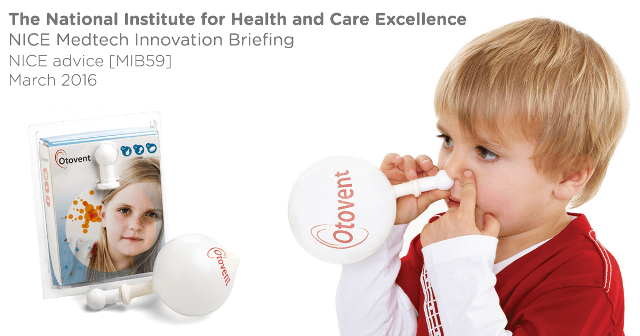An auto inflation device could be used as a first-line non-surgical, drug-free treatment option for glue ear according to a new report published by the National Institute for Health and Care Excellence.
Otovent, from Kestrel Medical, offers a non-invasive alternative to antibiotics and surgery for the 80% of children in the UK that suffer with Otitis Media with Effusion and should be used as a first-line treatment during or after the period of active observation following diagnosis, according to the Medtech Innovation Briefing report released today by the National Institute for Health and Care Excellence (NICE). Otovent works by using pressure from a balloon to help drain fluid that gets trapped in the middle ear and causes subsequent hearing problems.
As pointed out by the specialist commentators, parents are often disheartened when told to wait for 3 months to see if the symptoms of glue ear improve. They are therefore keen to try this treatment as it may reduce the need for grommet surgery and does not require high level of monitoring as opposed to hearing aids. Otovent will also allow parents to initially treat children in the home environment, without having to rely on antibiotics or surgery.
According to the report, Otovent can easily be incorporated into NHS clinics, along with information on the effectiveness and instruction on the method. If no clinician is available to show how to use the device correctly, there are a number of instructional videos available on the internet.
The report reviews four randomised clinical trials on Otovent involving a total of 565 children. All trials showed statistically significant improvements in middle ear function with Otovent compared with standard care. The improvements were determined by pneumatic optometry and tympanometry. No serious adverse effects associated with using the Otovent balloon were reported.
The latest trial of 320 children aged 4 to 11 years, undertaken by Dr Williamson at the University of Southampton, found that children using Otovent experienced fewer days with any glue-ear related symptoms compared to those that didn’t at both one (47.3% and 35.6%, respectively) and three months (49.6% and 38.3%, respectively). Otovent also produced greater improvements in ear-related quality of life assessed using the validated tool, a 14-point questionnaire on the impact of OME (OMQ-14).
Paediatrician Dr Ranj Singh said:
‘Glue ear can be problematic and frustrating for children and their parents. Despite the potentially significant consequences on development, there has traditionally been little in the way of treatment, other than surgery. Now for the first time, there is a real alternative that has clinically-proven results.’
‘By using an auto-inflation device, parents have a relatively non-invasive and low-cost option for helping to treat their child’s glue ear before thinking about surgery, potentially avoiding antibiotics. Such an easy-to-use and effective treatment has been long overdue!’
In 2013-2014 there were 22,809 operations for the insertion of grommets, at an average cost of £802 per operation. Treating patients with Otovent during the initial period of observation does not involve additional costs of monitoring. It is therefore suggested that Otovent might reduce costs to the NHS by reducing the need for surgical intervention. Additionally, to introduce Otovent as a first-line treatment in the care pathway, no changes would be needed in the organisation or delivery of current services and no other facilities or technologies would be needed.
It goes on to suggest that this treatment should be used more widely in children over the age of four to manage Otitis Media with Effusion and help treat the associated hearing loss.
Full report in PDF:
About Otovent and Glue Ear
Otovent consists of a small nasal device attached to a balloon which the child inflates through their nose. The act of blowing up the balloon helps to open up the Eustachian tube, making it easier for the fluid to drain from the middle ear and if used properly, the child’s hearing can improve in just a few days.
Otitis Media with Effusion, commonly known as Glue Ear, is a widespread condition that affects around 200,000 children every year in the UK and is most common in children under the age of ten . It’s caused when a sticky, glue-like fluid fills the middle ear and causes the child to have problems hearing. Ongoing hearing loss or pain often results in a grommet operation, which is the most common reason for general anaesthetic in children.
For more information about Otovent, watch the demonstration video below:




